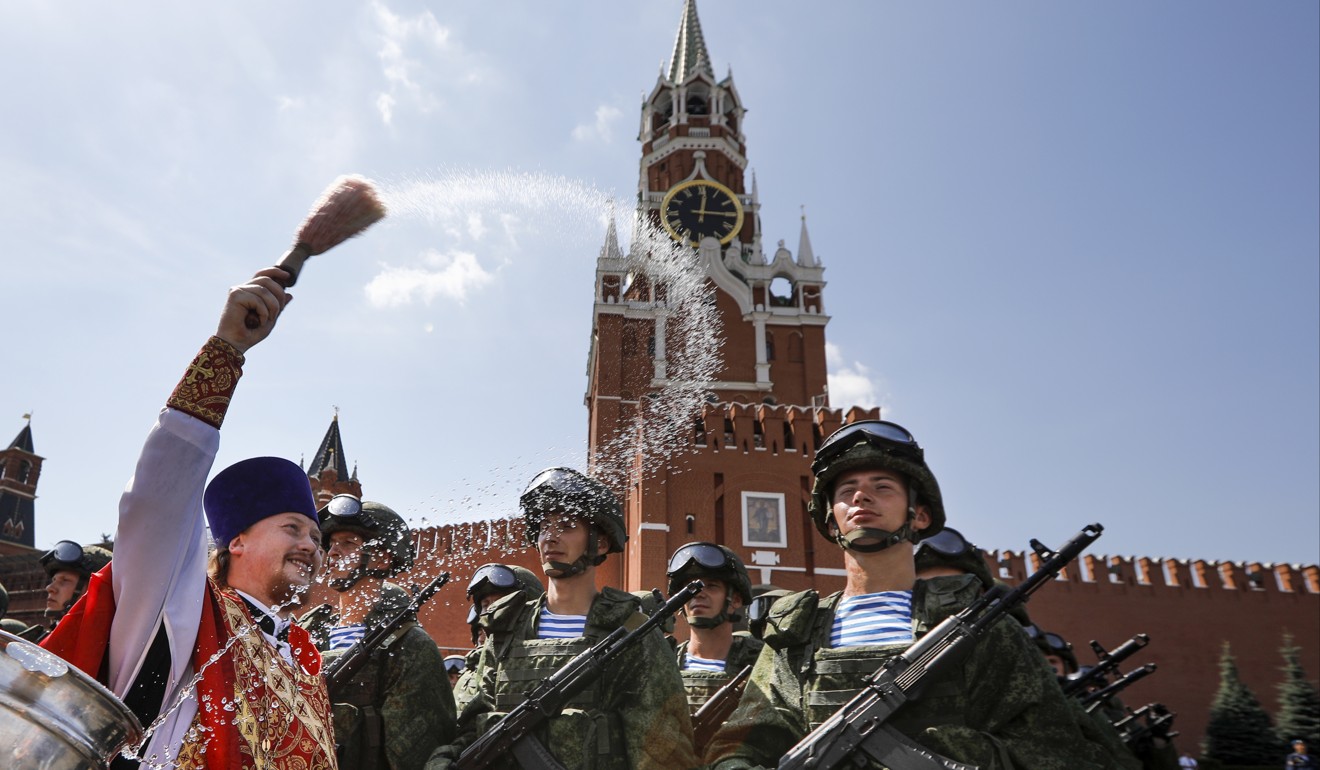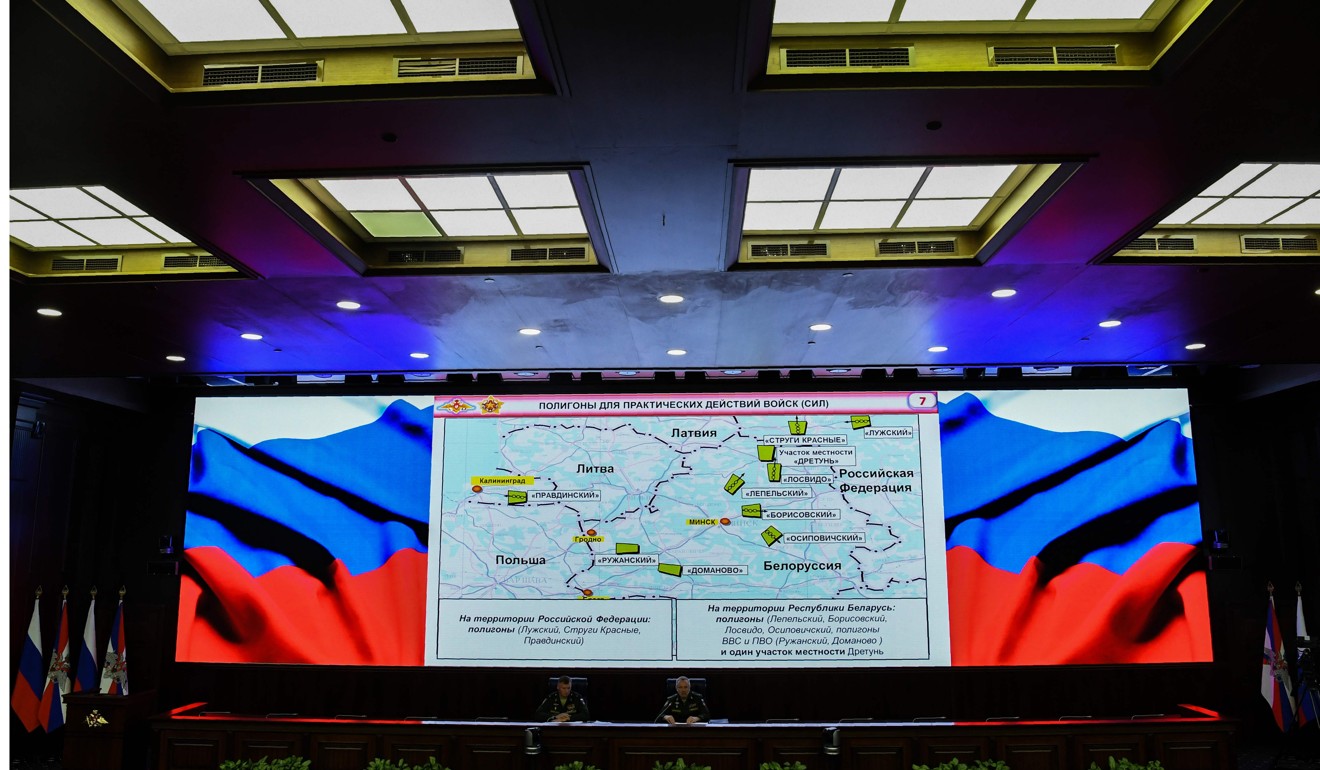
Russia kicks off Zapad-2017 war games against imagined enemy that isn’t Nato
Nato officials say the drills are intended to show Russia’s ability to mass large numbers of troops at very short notice in the event of a conflict
The last time Vladimir Putin sent thousands of troops into Belarus to defend against an imaginary invasion from the west, a real war erupted on Russia’s periphery within months – in Ukraine in 2014.
Even before Russian soldiers started roaming Belarus, a former Soviet republic that borders three Natoand European Union states plus Ukraine, western leaders accused Putin of deceit.
While Russia and Belarus say only 12,700 troops are involved – a level just shy of triggering compulsory international monitoring – Germany and Poland put the real total at more than 100,000. That estimate includes joint exercises in Kaliningrad, Russia’s nuclear-armed enclave on the Baltic Sea that’s nestled between Poland and Lithuania.

“We see a very, very large-scale offensive exercise that shows hatred against the West,” Lithuanian President Dalia Grybauskaite said in remarks published Wednesday.
She said it’s “clear” Putin will use Zapad 2017 as an excuse to deploy more weaponry and personnel along Russia’s borders and keep them there, according to a presidential spokeswoman in Vilnius.
Military planners in Moscow and Minsk say the basic scenario for the game involves tactical forces from a western alliance infiltrating Russia and Belarus through three fictional countries to carry out “terrorist” attacks.
These imaginary hostile powers, including states located in modern-day Poland and Lithuania, are trying to destabilise Belarus – a historical gateway to Moscow for would-be conquerors from Napoleon Bonaparte to Adolf Hitler – as Russia rushes to provide its ally with money, weapons and manpower.

Nato has strengthened its military presence in Poland and the three Baltic states amid growing distrust over Putin’s intentions since he annexed Crimea from Ukraine and stoked a separatist rebellion.
The Kremlin, for its part, accuses the US of reneging on a promise made after the Soviet Union collapsed not to expand all the way to Russia’s borders.
French Defence Minister Florence Parly last week condemned Zapad 2017 as another example of Putin’s “strategy of intimidation”, which includes a record number of Russian incursions into Nato airspace.
“Russia is testing us and testing us now at every opportunity,” British Defence Secretary Michael Fallon said this week.

Russia insists Zapad 2017 is “purely of a defensive nature’’ and won’t be used as cover to meddle in other countries.
Belarusian strongman Alexander Lukashenko, in power since 1994 and reliant on Russian subsidies, has so far rebuffed Putin’s request to establish a permanent base in his country.
The “hysteria” being whipped up in the West around Zapad 2017 is a ploy to justify new Nato deployments after the alliance stationed 4,000 troops in Poland and the Baltic states, said Igor Korotchenko, director of the Centre for Analysis of World Trade in Moscow.
Russian officials last year ordered 4,000 railcars specifically to transport soldiers and equipment to and from Belarus for the drills, raising concerns Russia’s military presence will linger long after the game ends.
The Defence Ministry in Minsk says all Russian soldiers involved in the drills will return by September 30, but that hasn’t reassured other neighbours, including Poland.
“Some of these forces may stay in Belarus, markedly changing the balance on Nato’s eastern flank,” Polish Defence Minister Antoni Macierewicz said September 1.
“That’s why these drills are a real threat.’’
Such shows of force have become a two-way street since Ukraine conflict started and Putin joined the protracted war in Syria, often putting Russia at odds with the US and its allies already fighting in the Middle East.
Last year, Nato staged one of the largest exercises in eastern Europe since the fall of the Berlin Wall, an event in Poland that drew 31,000 troops from 24 nations. The manoeuvres were based on a fictional scenario in which Estonia invokes Nato’s collective-defensive clause after threats from the make-believe nations of Bothnia and Torrike.

Like Russia, Bothnia has viewed Poland and the Baltic countries as hostile since they joined the alliance.
This June, Nato troops, including from Poland, Lithuania, the US and the UK, took part in the first-large scale exercises intended to demonstrate the alliance’s commitment to defending the strategically important Suwalki Gap – a 100-kilometre strip of land along the Polish-Lithuanian border.
If Russia were to seize the corridor, sandwiched between Zapad’s fictional states of Lubenia and Vesbaria, it would cut off the three former Soviet Baltic states – Lithuania, Latvia and Estonia – from the rest of Nato.
“Nato has only implemented important changes in our military posture as a response to a more assertive Russia,” Secretary General Jens Stoltenberg said at the Tapa military base in Estonia last week.

And the threat is accelerating, he said, “with more Russian troops close to our borders, with more modern Russian equipment and more exercises and not least of course with Russia using military force against a neighbour, against Ukraine.”
The Russian war games come as Ukraine on Monday launched annual joint military exercises with the US and a host of other NATO countries.
Additional reporting by Agence France-Presse and Reuters

